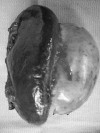Management options of colonoscopic splenic injury
- PMID: 16882428
- PMCID: PMC3016124
Management options of colonoscopic splenic injury
Abstract
Injury to the spleen during routine colonoscopy is an extremely rare injury. Diagnosis and management of the injury has evolved with technological advances and experience gained in the management of splenic injuries sustained in trauma. Of the 37 reported cases of colonoscopic splenic injury, 12 had a history of prior surgery or a disease process suggesting the presence of adhesions. Only 6 had noted difficulty during the procedure, and 31 patients experienced pain, shock, or hemoglobin drop as the indication of splenic injury. Since 1989, 21/24 (87.5%) patients have been diagnosed initially using computed tomography or ultrasonography. Overall, only 27.8% have retained their spleens. None have experienced as long a delay as our patient, nor have any had an attempt at percutaneous control of the injury. This report presents an unusual case of a rare complication of colonoscopy and the unsuccessful use of one nonoperative technique, and reviews the experience reported in the world literature, including current day management options.
Figures




References
-
- Shaker IS, Deckleman C. Delayed presentation of splenic rupture after colonoscopy. J Emerg Med. 1999; 17: 455– 457 - PubMed
-
- Wherry DC, Zehner H. Colonoscopy—Fiberoptic endoscopic approach to the colon and polypectomy. Med Ann DC. 1974; 43: 189– 192 - PubMed
-
- Adamek RJ, Wegener M, Schmidt-Heinevetter G, Ricken D, Jergas M. Milzruptur nach koloskopie: eine ungewOhnliche komplikation. Z Gastroenterol. 1992; 30: 139– 141 - PubMed
-
- Ahmed A, Eller P, Schiffman FJ. Splenic rupture: an unusual complication of colonoscopy. Am J Gastroenterol. 1997; 92: 1201– 1204 - PubMed
-
- Bergamaschi R, Arnaud J. Splenic rupture from colonoscopy (letter). Surg Endosc. 1997; 11: 1133. - PubMed
